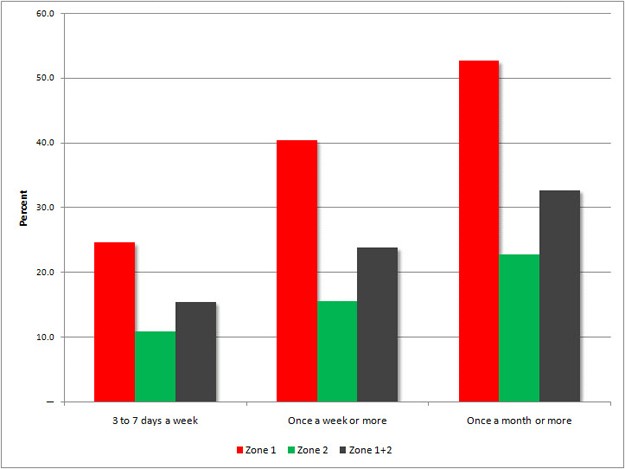
We know from travel surveys that public transport only accounts for a small proportion – around 10% – of all trips in Australia’s capital cities. Doesn’t sound like much.
But, as a new survey by the Australian Bureau of Statistics (ABS) shows, there’s more to how much we use public transport than is evident at first glance. There’s a big difference between what share of travel it captures and how many people use and rely on it.
What the ABS found is that while we mostly drive, many of us still use public transport for some of our travel. There are some places – most especially the city centre – where public transport is a much more attractive option than driving.
In a survey of adults in Melbourne, the Bureau found 38% said they had used public transport in the preceding month. Of this group, 24% say they use public transport at least once a week and 33% use it once a month or more (see exhibit).
The residents of inner and middle ring suburbs are even bigger users. In their case, 40% of the 1 million adults living within an 11-18 km radius around the CBD (Zone 1 in the fare structure) use public transport at least once a week and 53% at least once a month.
So while it’s correct to say that cars dominate travel in our capital cities, public transport is still used by a significant proportion of the population for certain kinds of trips.
The ABS didn’t ask what they use public transport for or where they were going, but we can be confident many commute regularly to work, mostly in the city centre. The figures indicate daily commuters aren’t the majority, though.
Most adults who travel by public transport use it for non-work trips. I expect most of it is trips to the centre or nearby – for example, to go to nightclubs, concerts, football matches, galleries, universities and restaurants. They use public transport for good reason.
Consider that nowadays the only AFL matches in Melbourne are played either at the MCG or Etihad Stadium in Docklands*. Around 80% of MCG patrons arrive and leave by public transport and I expect it’s similar, perhaps higher, at Etihad.
These patrons don’t leave their cars at home because they don’t like driving. They do it because traffic congestion, high parking costs and good match-day train and tram services make public transport a more attractive option than cars.
Drink driving laws probably help too, but the point is public transport is most times the better way to get to activities in the centre. Indeed, it’s often the only realistic option, even at night and on weekends.
The CBD and near-CBD are extremely important locations in Australian cities. Government planning policy in Victoria – which reinforces the primacy of the centre – is making the CBD and surrounds more and more important.
Travel surveys tell us what share of all trips is captured by each mode. They establish that public transport’s share is small relative to other modes (essentially cars) in Australian cities. This is useful and important information. However as the ABS survey shows, a large proportion of people use public transport on a reasonably frequent basis.
Public transport is needed by lots of people not just those who use it Monday to Friday. And it’s needed even though those same travellers make the majority of their other trips by car.
There are important implications in the findings of the ABS survey. One is obvious – governments need to invest more financial and political capital in improving public transport.
The other is less obvious – advocates shouldn’t limit themselves to presenting public transport solely as a replacement for cars. In the medium term at least, it’s much more likely to be an alternative for some trips and a complement for others (e.g. ‘kiss-and-ride’).
There are other interesting aspects of the ABS survey – like who uses public transport and why – I’ll come back to shortly.
* When I attended my first and last full AFL game in 1985 at Western Oval, there were five active suburban grounds at the time.







Crikey is committed to hosting lively discussions. Help us keep the conversation useful, interesting and welcoming. We aim to publish comments quickly in the interest of promoting robust conversation, but we’re a small team and we deploy filters to protect against legal risk. Occasionally your comment may be held up while we review, but we’re working as fast as we can to keep the conversation rolling.
The Crikey comment section is members-only content. Please subscribe to leave a comment.
The Crikey comment section is members-only content. Please login to leave a comment.